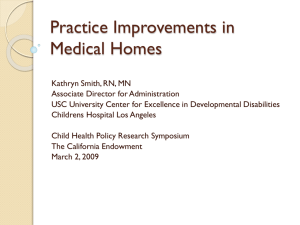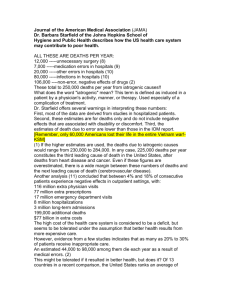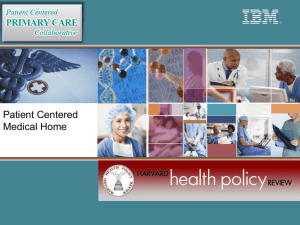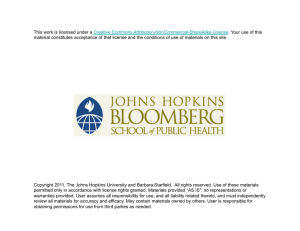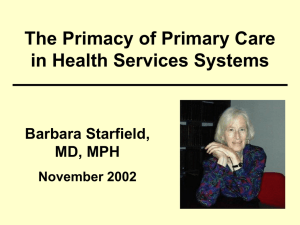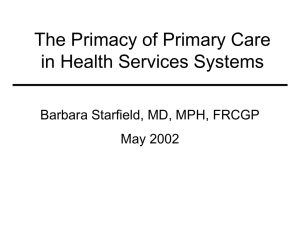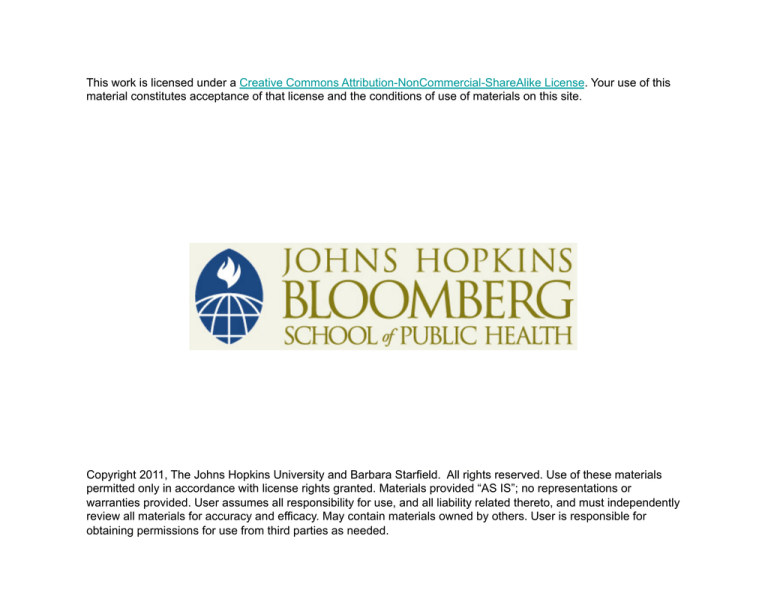
This work is licensed under a Creative Commons Attribution-NonCommercial-ShareAlike License. Your use of this
material constitutes acceptance of that license and the conditions of use of materials on this site.
Copyright 2011, The Johns Hopkins University and Barbara Starfield. All rights reserved. Use of these materials
permitted only in accordance with license rights granted. Materials provided “AS IS”; no representations or
warranties provided. User assumes all responsibility for use, and all liability related thereto, and must independently
review all materials for accuracy and efficacy. May contain materials owned by others. User is responsible for
obtaining permissions for use from third parties as needed.
Benefits of Primary
Care in Healthcare
Reform
Barbara Starfield, MD, MPH
Sommer Memorial Lecture (Portland, OR, 2010)
and Herbert Vaughn Lecture (Boston, MA, 2010
Why Is Primary Care
Important?
Better health outcomes
Lower costs
Greater equity in health
Starfield 07/07
PC 6306 n
Evidence for the benefits of primary care-oriented
health systems is robust across a wide variety of
types of studies:
• International comparisons
• Population studies within countries
– across areas with different primary care
physician/population ratios
– studies of people going to different types of
practitioners
• Clinical studies
– of people going to facilities/practitioners differing
in adherence to primary care practices
Source: Starfield et al, Milbank Q 2005; 83:457-502.
Starfield 03/08
PC 6924 n
Primary Care Scores, 1980s and 1990s
1980s
1990s
Belgium
France*
Germany
United States
0.8
0.5
0.2
0.4
0.3
0.4
0.4
Australia
Canada
Japan*
Sweden
1.1
1.2
1.2
1.1
1.2
0.8
0.9
Denmark
Finland
Netherlands
Spain*
United Kingdom
1.5
1.5
1.5
1.7
1.7
1.5
1.5
1.4
1.9
*Scores available only for the 1990s
Starfield 07/07
ICTC 5446 an
System Features Important to Primary Health Care
Resource
Allocation Progressive
Cost
Compre(Score)
Financing* Sharing hensiveness
Belgium
France
Germany
US
0
0
0
0
0
0
1
0**
0
0
2
0
0
0
0
0
Australia
Canada
Japan
Sweden
1
1
1
2
2
2
2
2
2
2
1
1
2
2
1
1
Denmark
Finland
Netherlands
Spain
UK
2
2
2
2
2
2
2
0
2
2
2
1
2
2
2
2
2
2
1
2
Sources: Starfield. Primary Care: Balancing Health Needs, Services, and
Technology. Oxford U. Press, 1998. van Doorslaer et al. Equity in the Finance and
Delivery of Health Care: An International Perspective. Oxford U. Press, 1993.
*0=all regressive
1=mixed
2=all progressive
**except Medicaid
Starfield 11/06
EQ 5599 n
Primary health care oriented countries
• Have more equitable resource distributions
• Have health insurance or services that are
provided by the government
• Have little or no private health insurance
• Have no or low co-payments for health services
• Are rated as better by their populations
• Have primary care that includes a wider range
of services and is family oriented
• Have better health at lower costs
Sources: Starfield and Shi, Health Policy 2002; 60:201-18.
van Doorslaer et al, Health Econ 2004; 13:629-47.
Schoen et al, Health Aff 2005; W5: 509-25.
Starfield 11/05
IC 6311
System (PHC) and Practice (PC) Characteristics
Facilitating Primary Care, Early-Mid 1990s
GER
FR
BEL
US
SWE
JAP
CAN
FIN
AUS
SP
DK
NTH
UK
*Best level of health indicator is ranked 1; worst is ranked 13;
thus, lower average ranks indicate better performance.
Based on data in Starfield & Shi, Health Policy 2002; 60:201-18.
Starfield 03/05
ICTC 5366 an
Primary Care Score vs. Health
Care Expenditures, 1997
UK
DK
NTH
SP
FIN
AUS
SWE
CAN
JAP
GER
BEL
FR
Based on data in Starfield & Shi, Health Policy 2002; 60:201-18.
US
Starfield 11/06
ICTC 5365 an
Primary Care Strength and Premature
Mortality in 18 OECD Countries
Starfield 11/06
IC 5903 n
Primary Care Score and Health
Outcomes: 18 OECD Countries
*Primary care coefficient significant at p<0.05 level and estimated by fixed effects, using pooled
cross-sectional time series design. Analysis controlled for GDP, percent elderly, doctors/capita,
average income (ppp), alcohol and tobacco use. R2(within) averaged from to .36 to .84.
Source: Macinko et al, Health Serv Res 2003; 38:831-65.
Starfield 11/02
IC 5904 n
Primary Care Oriented
Countries Have
• Fewer low birth weight infants
• Lower infant mortality, especially
postneonatal
• Fewer years of life lost due to suicide
• Fewer years of life lost due to “all except
external” causes
• Higher life expectancy at all ages except
at age 80
Sources: Starfield. Primary Care: Balancing Health Needs, Services, and
Technology. Oxford U. Press, 1998. Starfield & Shi, Health Policy 2002; 60:201-18.
Starfield 07/07
IC 6341 n
Technology Use: Relative Ranking
(Rates per Million Population)
Country
Allogeneic
CT
MRI
CABG
PTCA
bone marrow
scanner† scanner* procedures* procedures* transplant**
Australia
Germany (West)
US
6
5
7
3
6
7
4
2
7
3
5
7
6
1
4
Canada
2
1
6
6
7
5
3
1
3
2
8
5
Denmark
Netherlands
Sweden
UK
3
4
1
4
5
2
5
3
1
Sources:
†OTA 1984, as cited in Battista et al, Health Policy 1994; 30:397-421, data for 1990.
* Battista et al, Health Policy 1994; 30:397-421; data for 1992, 1990, 1991, respectively.
**Silberman et al, N Engl J Med 1994; 331:1063-7, data for 1989-91.
Starfield 09/02
IC 5928 n
Any Error: Medical Mistake, Medication
Error, or Lab/Diagnostic Test Error in
Past 2 Years
Source: Schoen et al, Health Affairs 2005; W5: 509-525.
Starfield 01/06
IC 6519 n
Percent of Patients Reporting Any
Error by Number of Doctors Seen
in Past Two Years
Country
One doctor 4 or more doctors
Australia
12
37
Canada
15
40
Germany
14
31
New Zealand
14
35
UK
12
28
US
22
49
Source: Schoen et al, Health Affairs 2005; W5: 509-525.
Starfield 09/07
IC 6525 n
Comparisons of Policy (PHC)
and Clinical (PC) Characteristics
Canada
UK
US
System characteristics related to primary care
Type of system
1.0
2.0
0.0
Financing
2.0
2.0
0.0
Cost sharing for primary care
2.0
2.0
0.0
First contact
1.0
2.0
1.0
Longitudinality
1.0
2.0
0.0
Comprehensiveness
2.0
2.0
0.0
Coordination
0.5
1.0
0.0
Family-centeredness
1.0
2.0
0.5
Community orientation
0.5
2.0
0.0
Primary care practice characteristics
Source: Starfield & Shi, Health Policy 2002;60:201-18.
Starfield 07/09
IC 7146 an
Health “Outcomes”: Canada vs. US*
(Rank among OECD Countries, 2004-5)
*age standardized
where appropriate
LE birth
9 vs 25
LE age 65 (males)
4 vs 8
LE age 65 (females)
4 vs 14
PYLL (age 70)
13 vs 21
IHD mortality (males)
7 vs 5
IHD mortality (females)
7 vs 9
Stroke mortality (males)
2 vs 4
Stroke mortality (females)
3 vs 6
All cancer mortality (males)
12 vs 7
All cancer mortality (females)
22 vs 23
Infant mortality
24 vs 26
Asthma mortality ages 5-39
18 vs 21
Sources: OECD Health data 2009. Starfield, Re-inventing primary
care: lessons from Canada. Health Aff 2010 forthcoming.
Starfield 02/10
IC 7157 n
A review of 38 studies addressing diverse
clinical problems found that, overall,
quality of care is better in Canada than in
the United States. Of 10 studies that
included extensive statistical adjustment
and enrolled broad populations, five
favored Canada, two favored the US, and
three showed equivalent or mixed results.
Source: Docteur & Berenson: How Does the Quality of U.S. Health Care Compare
Internationally? (http://www.rwjf.org/files/research/qualityquickstrikeaug2009.pdf,
accessed September 30, 2009). Robert Wood Johnson Foundation, 2009. Based on
Guyatt et al, Open Med 2007;1:E27-36.
Starfield 09/09
IC 7215
In British Columbia, every additional 1%
increase in continuity of care is
associated with a saving of about $81
per year per person with diabetes. A 5%
increase would save about 85 million
dollars in the care of people with high
burdens of morbidity with their diabetes
or congestive heart failure. The benefit
of continuity of primary care is
especially great for people with complex
morbidity patterns.
Source: Hollander et al, Healthc Q 2009;12:30-42.
Starfield 09/08
LONG 7199
A study of individuals seen in a year in large health
care plans in the US found:
percent who saw a
specialist
average number of
different specialists seen
average number of visits
to specialists
total visits to both
primary care and
specialists
Source: Starfield et al, J Ambul Care Manage 2009;32:216-25.
elderly
95
non-elderly
69
4.0
1.7
8.8
3.3
11.5
5.9
Starfield 02/10
COMP 7284 n
A study of individuals (ages 20-79) seen
over two years in Ontario, Canada,
found:
percent who saw a specialist
median number of visits to
specialists
total visits to both primary
care and specialists
Source: Sibley et al, Med Care 2010;48:175-82.
53.2
1.0
7.0
Starfield 02/10
COMP 7322 n
Generalists and Specialists per
100,000 People, US and
Canada, 2006-7
Generalists
(FP, GIM, general peds)
Specialists
Source: Starfield, Re-inventing primary care: lessons
from Canada. Health Aff 2010 forthcoming.
US
100
Canada
99
207
94
Starfield 03/10
IC 7321 n
In both England and the US, each
additional primary care physician per
10,000 population (a 12-20% increase)
is associated with a decrease in
mortality of 3-10%, depending on the
cause of death. This is true even after
adjusting for sociodemographic and
socioeconomic characteristics.
Source: Gulliford, J Public Health Med 2002; 24:252-4,
and personal communication 9/04.
Starfield 03/05
WC 6313
Many other studies done WITHIN countries,
both industrialized and developing, show that
areas with better primary care have better
health outcomes, including total mortality
rates, heart disease mortality rates, and
infant mortality, and earlier detection of
cancers such as colorectal cancer, breast
cancer, uterine/cervical cancer, and
melanoma. The opposite is the case for
higher specialist supply, which is associated
with worse outcomes.
Sources: Starfield et al, Milbank Q 2005;83:457-502.
Macinko et al, J Ambul Care Manage 2009;32:150-71.
Starfield 09/04
WC 6314
Across the US states, there is a greater relationship
between the presence of a good supply of physicians and
life expectancy than there is either between high
coverage with health insurance among the state
population or affordability of health insurance coverage
and life expectancy.
It is the availability of primary care resources that has the
determining effect on access to the benefits of primary
care. Insurance alone, without regulated benefits,
copayments and deductibles under either direct provision
of services (as in federally qualified community health
centers), a single payer (generally the government), or
government regulated private insurance is not sufficient to
provide the benefits to health.
Data from: Emanuel, JAMA 2008;299:947-9. Shi et al, J Fam Pract 1999;48:275-84.
Starfield 02/10
WCUS 7285
Why Does Primary Care Enhance
Effectiveness of Health Services?
• Greater accessibility
• Better person-focused prevention
• Better person-focused quality of clinical
care
• Earlier management of problems (avoiding
hospitalizations)
• The accumulated benefits of the four
features of primary care
Source: Starfield et al, Milbank Q 2005;83:457-502.
Starfield 05/09
PC 7121
Does primary care
reduce inequity in
health?
Starfield 07/07
EQ 6323 n
In the United States, an increase of
1 primary care doctor is associated
with 1.44 fewer deaths per 10,000
population.
The association of primary care
with decreased mortality is greater
in the African-American population
than in the white population.
Source: Shi et al, Soc Sci Med 2005; 61(1):65-75.
Starfield 07/07
WCUS 5980 n
Odds Ratios for Poor Mental Health Status
by Adequacy of Primary Care in Different
Population Groups, US, 1998-1999
Source: Shi et al, J Am Board Fam Pract 2004; 17:443-52.
Starfield 09/04
WCUS 6268 n
Odds Ratios for Poor Physical Health Status
by Adequacy of Primary Care, in Different
Population Groups, US, 1998-1999
Source: Shi et al, J Am Board Fam Pract 2004; 17:443-52.
Starfield 09/04
WCUS 6267 n
A comparison of age-adjusted survival from breast
cancer showed that
• Low SES is strongly associated with decreased
survival in US, but not Canada.
• The survival advantage in Canada is present in
low income areas only.
• The survival advantage in Canada is much
larger at ages under 65.
• The Canadian survival advantage is larger for
later stage diagnosis. That is, there is almost
certainly a medical care benefit to equity in the
Canadian context.
Source: Gorey, Int J Epidemiol 2009;38:1543-51 .
Starfield 08/09
IC 7158 n
In Ontario Canada, family income is
unrelated to either likelihood of
seeking care or frequency of visits to
either primary or specialist care, even
after controlling for morbidity burden.
However, higher levels of education
were associated with higher
likelihood of visiting a specialist and
with more specialist visits.
Source: Glazier et al, Ann Fam Med 2009;7:396-405.
Starfield 09/09
EQ 7214
Why Does Primary Care Enhance
Equity in Health?
• Greater comprehensiveness of services
(especially important in the presence of
multimorbidity)
• Person-focused care over time (better knowledge
of patient and better recognition of problems)
• Greater accessibility of services
• Better coordination, thus facilitating care for
people of limited flexibility
• Better person-focused prevention
Source: Starfield et al, Milbank Q 2005;83:457-502.
Starfield 05/09
PC 7120
Primary Care and Health:
Evidence-Based Summary
• Countries with strong primary care
– have lower overall costs
– generally have healthier populations
• Within countries
– areas with higher primary care physician
availability (but NOT specialist availability) have
healthier populations
– more primary care physician availability reduces
the adverse effects of social inequality
Starfield 09/02
PC 5485 n
Conclusion
Although sociodemographic factors
undoubtedly influence health, a primary
care oriented health system is a highly
relevant policy strategy because its
effect is clear and relatively rapid,
particularly concerning prevention of
the progression of illness and effects of
injury, especially at younger ages.
Starfield 11/05
HS 6310
Strategy for Change in Health Systems
•
•
•
•
•
•
•
•
•
•
Achieving primary care
Avoiding an excess supply of specialists
Achieving equity in health
Addressing co- and multimorbidity
Responding to patients’ problems: using ICPC for
documenting and follow-up
Coordinating care
Avoiding adverse effects
Adapting payment mechanisms
Developing information systems that serve care
functions as well as clinical information
Primary care-public health link: role of primary care
in disease prevention
Starfield 11/06
HS 6457 n
Aspects of Care That Distinguish
Conventional Health Care from PeopleCentred Primary Care
Source: World Health Organization. The World Health Report 2008:
Primary Health Care – Now More than Ever. Geneva, Switzerland, 2008.
Starfield 05/09
PC 7123 n
Good Primary Care Requires
• Health system POLICIES conducive to primary care
practice: What can we learn from other countries
about the relative merits of direct provision of
services rather than just financing of services?
• Health services delivery that achieves the important
FUNCTIONS of primary care: What can be done to
enhance practitioners’ recognition of and
responsiveness to patients’ problems (patient-focus)
rather than on the professional priorities of
diagnoses (diagnosis-focus)?
Starfield 06/08
PC 6992
Joint Principles of the Patientcentered Medical Home
• Personal physician: ongoing relationship for first
contact, continuous, comprehensive care
• Clarification of specialist role(s)
• Whole person oriented
• Coordinated and/or integrated care
• Quality and safety
• Enhanced access
• Added value payment
• Primary care/public health links
Source: AAFP/AAP/ACP/AOA. Joint Principles. March 2007.
Starfield 03/08
MH 6958 n
Proposed PC/MH (Patientcentered Medical Home) Criteria
• Electronic health record
• Teams
• Chronic care guidelines
Question: Do these
“enhancements” improve primary
care?
This requires evaluation.
Starfield 06/08
MH 6997 n
“Enhancements” to Primary Care
•
•
•
•
Health information systems: primary care/system-wide
Subspecialization in primary care
Patient-centered primary care (poorly conceptualized)
“Chronic care model”: self-management support;
delivery system design; decision support; clinical;
information systems
• A focus on specific chronic diseases rather than a
focus on the combination of health problems
experienced by people
• The patient-centered medical home
ALL REQUIRE EVALUATION.
Starfield 02/08
PC 6920
We have instruments to assess
the utility of health systems, the
strength of primary care, and
the outcomes as measured by
morbidity burden. We need the
political will to use them.
Starfield 08/09
PCM 7164
US Health Care Reform
and Primary Care –
March 2010
Starfield 04/10
WCUS 7358
Primary Care and US Health
Care Reform – Likely Benefits
• More primary care physicians (5-10 years);
preference for primary care in unused residency
slots paid by Medicare
• Better primary care training-teaching health
centers and payment by Medicare for outpatient
training
• More community health centers and NHSC
physicians in socially deprived areas
• Higher Medicare reimbursement for 2 years;
10% increase in reimbursement for 5 years
Starfield 04/10
WCUS 7359
Primary Care and US Health
Care Reform – Likely Problems
• Increased pressure on ERs
• More problems with access to primary
care (5-10 years)
• Increased pressure on primary care
physicians
• Less availability for dealing with patients’
problems
• More focus on routine management
Starfield 04/10
WCUS 7360
Primary Care and US Health
Care Reform – Likely Problems
• More use, especially at ages 45-64
• More procedures, especially at ages 45-64
• Continued high administrative costs and/or
reclassification as medical costs*
• Continued escalation of high technology
interventions**
• Continued escalation of polypharmacy**
*Law requires insurers to spend at least 80% of premium on medical care.
**Law prohibits costs-effectiveness research from influencing payments for care.
Starfield 04/10
WCUS 7361
What to Do – Fast
• Maintain state option for single payor
• Encourage routine care to be done by
non-physician practitioners (would
relieve up to half of the clinical time of
primary care physicians)
Starfield 04/10
WCUS 7362


